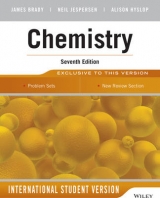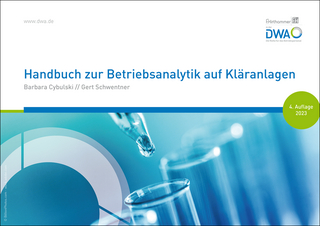
Chemistry
John Wiley & Sons Ltd (Verlag)
978-0-470-64617-5 (ISBN)
- Titel erscheint in neuer Auflage
- Artikel merken
There are problem sets called "Bringing It Together" that contain problems which require students to bring together concepts from two or more of the preceding chapters. This reinforces learned concepts and builds concept mastery.
Chapter 1 Chemistry and the Atomic/Molecular View of Matter. 1.1 Chemistry and Its Place Among the Sciences. 1.2 Laws and Theories: The Scientific Method. 1.3 Matter and Its Classifications. 1.4 Dalton and the Atomic Theory. 1.5 Atoms and Molecules and Chemical Formulas. 1.6 Chemical Reactions and Chemical Equations. Chapter 2 Scientific Measurements. 2.1 Physical and Chemical Properties. 2.2 Measurement of Physical and Chemical Properties. 2.3 The Uncertainty of Measurements. 2.4 Dimensional Analysis. 2.5 Density and Specific Gravity. Chapter 3 Elements, Compounds, and Chemical Reactions. 3.1 Internal structure of the atom. 3.2 The Periodic Table. 3.3 Metals, Nonmetals, or Metalloids. 3.4 Ionic Compounds . 3.5 Nomenclature of Ionic Compounds. 3.6 Molecular Compounds. 3.7 Naming molecular compounds. Chapter 4 The Mole and Stoichiometry. 4.1 The molecular scale vs. the laboratory scale 4.2 Chemical formulas and stoichiometry. 4.3 Determining empirical and molecular formulas. 4.4 The Mole and Chemical Reactions. 4.5 Limiting Reactants and Theoretical Yield. 4.6 Percentage Yield. Chapter 5 Molecular View of Reactions in Aqueous Solutions. 5.1 Describing Solutions. 5.2 Electrolytes, Weak electrolytes, and Non-electrolytes. 5.3 Acids and Bases. 5.4 Acid-Base Nomenclature. 5.5 Double-Replacement (Metathesis) Reactions. 5.6 Molarity. 5.7 Solution Stoichiometry. 5.8 Titrations and Chemical Analysis. Chapter 6 Oxidation Reduction (RedOx) Reactions. 6.1 Oxidation-Reduction Reactions. 6.2 Balancing Redox Reactions. 6.3 Acids as Oxidizing Agents. 6.4 Activity Series of Metals. 6.5 Molecular Oxygen as an Oxidizing Agent. 6.6 Stoichiometry of Redox reactions. Chapter 7 Energy and Chemical Change. 7.1 Energy: The Ability to do Work. 7.2 Internal Energy. 7.3 Measuring Heat. 7.4 Energy of chemical reactions. 7.5 Heat, Work and the First Law of Thermodynamics. 7.6 Heats of Reaction. 7.7 Thermochemical Equations. 7.8 Hess's Law. 7.9 Standard Heats of Reaction. Chapter 8 The Quantum Mechanical Atom. 8.1 Electromagnetic Radiation. 8.2 Line Spectra and the Rydberg Equation. 8.3 The Bohr Theory. 8.4 The Wave Mechanical Model. 8.5 Quantum Numbers of Electrons in atoms. 8.6 Electron spin. 8.7 Energy Levels and Ground State Electron Configurations. 8.8 Periodic Table and Ground State Electron Configurations. 8.9 Atomic Orbitals: Shapes and Orientations. 8.10 Periodic Table and Properties of the Elements. Chapter 9 The Basics of Chemical Bonding. 9.1 Energy Requirements for Bond Formation. 9.2 Ionic Bonding. 9.3 Electron Configurations of Ions. 9.4 Lewis Symbols: Keeping Track of Valence Electrons. 9.5 Covalent Bonds. 9.6 Covalent Compounds of Carbon. 9.7 Bond Polarity and Electronegativity. 9.8 Lewis Structures. 9.9 Resonance Structures. Chapter 10 Theories of Bonding and Structure. 10.1 Five Basic Molecular Geometries. 10.2 Molecular Shapes and the VSEPR Model. 10.3 Molecular Structure and Dipole Moments. 10.4 Valence Bond Theory. 10.5 Hybrid Orbitals and Molecular Geometry. 10.6 Hybrid Orbitals and Multiple Bonds. 10.7 Molecular Orbital Theory Basics. 10.8 Delocalized Molecular Orbitals. 10.9 Bonding in Solids. 10.10 Atomic Size and the Tendency Toward Multiple Bond Formation. Chapter 11 Properties of Gases. 11.1 A Molecular Look at Gases. 11.2 Measurement of Pressure. 11.3 Gas Laws. 11.4 Stoichiometry Using Gas Volumes. 11.5 Ideal Gas Law. 11.6 Dalton s Law of Partial Pressures. 11.7 Kinetic Molecular Theory. 11.8 Real Gases. 11.9 Chemistry of the Atmosphere. Chapter 12 Liquids, Solids, and Intermolecular Forces. 12.1 Gases, Liquids, and Solids and Intermolecular Distances. 12.2 Types of Intermolecular Forces. 12.3 Intermolecular Forces and Properties of Liquids and Solids. 12.4 Changes of State and Dynamic Equilibria. 12.5 Vapor Pressures of Liquids and Solids. 12.6 Boiling Points of Liquids. 12.7 Energy and Changes of State. 12.8 Determining Heats of Vaporization. 12.9 Le Chatelier's Principle and State Changes. 12.10 Phase Diagrams. 12.11 Structure of Crystalline Solids. 12.12 X-Ray Diffraction of Solids. 12.13 Crystal Types and Physical Properties. Chapter 13 Mixtures at the Molecular Level: Properties of Solutions. 13.1 Intermolecular Forces and the Formation of Solutions. 13.2 Heats of Solution. 13.3 Solubility as a Function of Temperature. 13.4 Henry's Law. 13.5 Temperature Independent Concentration Units. 13.6 Temperature Dependent Concentration Units. 13.7 Colligative Properties. 13.8 Heterogeneous Mixtures. Chapter 14 Chemical Kinetics. 14.1 Factors That Affect Reaction Rates. 14.2 Measuring Reaction Rates. 14.3 Rate Laws. 14.4 Integrated Rate Laws. First order reactions. 14.5 Molecular Basis of Collision Theory. 14.6 Molecular Basis of Transition State Theory. 14.7 Activation Energies. 14.8 Mechanisms of Reactions. 14.9 Catalysts. Appendix A: Review of Mathematics. Appendix B: Answers to Practice Exercises and Selected Review Problems. Appendix C: Tables of Selected Data. Glossary. Index.
| Zusatzinfo | Illustrations (some col.) |
|---|---|
| Verlagsort | Chichester |
| Sprache | englisch |
| Maße | 216 x 278 mm |
| Gewicht | 2406 g |
| Themenwelt | Naturwissenschaften ► Chemie |
| ISBN-10 | 0-470-64617-9 / 0470646179 |
| ISBN-13 | 978-0-470-64617-5 / 9780470646175 |
| Zustand | Neuware |
| Haben Sie eine Frage zum Produkt? |
aus dem Bereich



